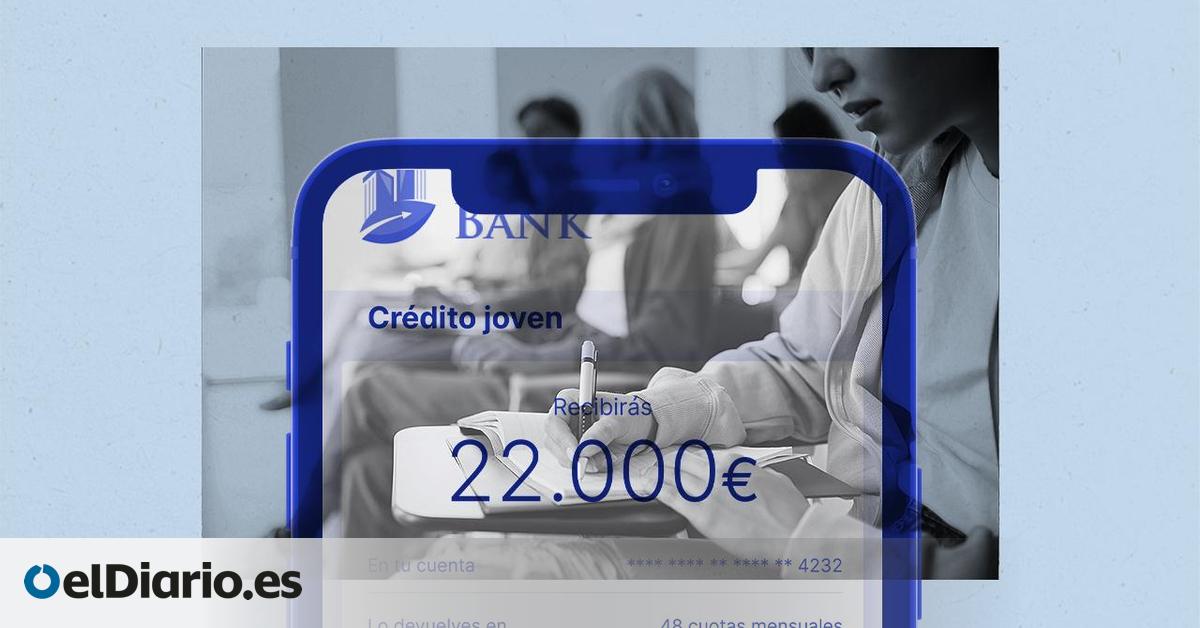
One in every seven credits requested is used to pay for studies, basically university and more specifically private centers. The “emergence” of these campuses in Spain, especially in the last decade, is mutating the higher education system in the country, leading more families to go into debt, according to Asufin (Association of Financial Users). The figure, driven by the blockage in public supply, has risen 60% in five years.
The drift of the system has been relatively rapid. At the beginning of the century, the Bologna plan enshrined the commitment to postgraduate courses and specialization, differentiated from basic university training, degrees. Enrollments for master’s degrees skyrocketed, and poorly funded public universities found themselves unable to meet that demand. The same thing happened with the degrees. Young people, aware that training at university – also applies to some vocational training – can mean up to double the salary than not doing so and that in a competitive labor market that has never been competitive, one must differentiate themselves from those next to them, they press on, study, do a master’s degree, a postgraduate degree, another master’s degree. For some professions – lawyer, secondary school teacher – they are even mandatory. You have to do them, it doesn’t matter where. Doesn’t the public offer me a place? I’m going private. That I don’t have the money to pay tuition fees that can range between 6,500 and 10,000 euros per year, with peaks of 30,000 for careers like Medicine? I ask the bank.
The result? In the last quarter of a century, 27 private universities have opened and soon they will be the majority when not so long ago, back in 2004, the ratio was 50-22. Since this year, there are already more people studying master’s degrees in private centers than in public ones. The sector’s turnover has gone from 2,255 million euros in 2017 to 3,700 million euros in 2023, according to the sector observatory DBK Informa, an increase of 68%, and this year one in every seven loans requested from banks has studies as its purpose, according to the VII Consumer Loan Barometer of Asufin (Association of Financial Users).
“This happens not because students want to go to the private one, the first option is still the public one,” reflected the Minister of Universities, Diana Morant, when the Government approved the tightening of the requirements to create universities with which it intends to limit the boom from private centers. “But public universities do not have enough offerings due to the underfunding of the autonomous communities. This causes cut-off grades to rise and public universities are perceived as elitist. [Estamos] worried because in the future we are going to return to that Spain in which you study or not depending on your income. 14% of credits that are subscribed are already to finance university payments,” he noted.
The third reason to request a loan
In 2020, the loans requested to pay for studies were 8.8%. It is an increase of 60%. Today, this motivation is already the third when applying for credit, behind consumption (buying a vehicle, etc.) and the need for money in general. “There is a very big challenge at the moment because salaries are not very high,” explains Antonio Gallardo, from Asufin, about this increase. “So, there is a conviction that you can improve professionally with training, competition is increasing and the interest of universities in offering degrees, especially postgraduate degrees, is skyrocketing. And many times they come packaged: they offer you education, but also financing. Especially the private ones,” he elaborates.
According to the information Asufin handles, families generally request two types of credits to study. On the one hand, there are shorter-term loans, of not very high amounts, which are intended primarily to cover tuition fees and are usually between 6,000 and 10,000 euros, “to be repaid in very short terms, 12-18 months,” explains Gallardo. “There is a second type, of larger amounts, going up to 25,000 euros, and intended for postgraduate studies. The main characteristic compared to the other loan is that they usually offer a waiting period [un plazo de tiempo durante el que no hay que devolver el crédito] higher, up to six or twelve months because it is assumed that with your future employability you will satisfy them.”
More and more families are going into debt to finance studies that the state does not offer, somewhat in line with the American education model, although far removed both in its impact and in the numbers. In the world’s leading economy, high tuition costs and ease of access have led to 43 million students owing banks $1.6 billion (€1.36 billion). Nothing close to what is handled here, but when you go down to detail you see that each student spends between 10,000 and 70,000 euros to pay for their university studies, according to the Pew Research Center. Studying Medicine at a private university in Spain does not cost less than that maximum.
A plug that pushes into the private
As Morant explained, there has been a plug in the public university for years. With little funding from the autonomous communities, the public offer has basically stagnated in the last ten years: in Spain, face-to-face public universities offered 245,956 places in the 2023-24 academic year (the last one for which there is consolidated data), a figure that a decade before was basically the same (there were a thousand more places). But in this time the number of university students has increased by 21%. Where have they gone? To the only place they could. Private universities have gained 129% of students in this period, public universities 2%.
But, as the minister said, it is not by choice. That quarter of a million places received a total of 475,500 pre-registrations. In other words, there are almost two applications for each one and degrees with averages of 11 applicants per place, such as Medicine. At the Public University of Navarra or Cantabria, almost 40 applicants have registered this year for each place offered for these studies. In total there are 12 degrees throughout Spain in which 20 or more people aspire to each place offered. The cut-off grades skyrocket and those who want to take a degree and another is not worth it have only one option: pay, even if they have almost a 13 out of 14, as has happened this same year to María Fomina. In careers like Dentistry, there are already more people taking it in private courses than in public ones, at a rate of 15,000 or 20,000 euros per course.
On average, each higher education student who attends a private center spends 6,358 euros each course, a statistic that higher vocational training pulls down with prices significantly lower than the university. Private is expensive, but public is not cheap either: those who use the public system spend 1,533 euros annually, always according to the Household Expenditure on Education Survey of the National Institute of Statistics for the 2023-2024 academic year, the latest data available. Those same figures were 664 euros in public and 4,656 euros in private in 2019 – always on average and with the FP effect – which means that in the five years that have passed, public spending has more than doubled while private spending has increased by 30%.
While this is happening, a paradox occurs: on the one hand, an agreement in 2020 caused the autonomous communities with the most expensive public prices to lower the cost of their studies (although there are still large differences between regions); On the other hand, many communities are implementing or extending free initial registrations. But the cap on places limits who can benefit from these measures because not everyone fits, only those with the best grades can aspire to a public place. And performing in high school and high school is also a matter of class.
Source: www.eldiario.es

